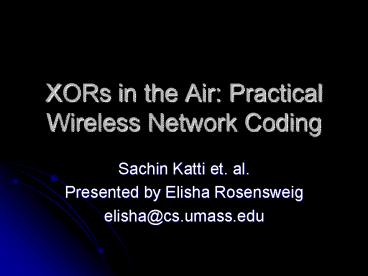XORs in the Air: Practical Wireless Network Coding - PowerPoint PPT Presentation
Title:
XORs in the Air: Practical Wireless Network Coding
Description:
Decode. XOR received packet with all packets pj, j i. Only decode when annotation ... Chance that XORed packet can be decoded by user i is Qi = pji Pij ... – PowerPoint PPT presentation
Number of Views:76
Avg rating:3.0/5.0
Title: XORs in the Air: Practical Wireless Network Coding
1
XORs in the Air Practical Wireless Network Coding
- Sachin Katti et. al.
- Presented by Elisha Rosensweig
- elisha_at_cs.umass.edu
2
Talk Outline
- Theory
- Network Coding Intro
- Theoretical model bounds
- Emergent properties
- Practice COPE architecture
- COPE specification
- Results \ Simulation analysis
- Applications
- Whats next?
3
Network Coding
- Use receiver-context to share single transmission
between several receivers - Transmission decoded based on context
- Assumes broadcast\multicast
- Context can be anything
- Personalized key
- Previous transmissions
- Standard network coding
4
Network Coding - concept
Based on the Chinese Remainder Theorem
27!
5
Network Coding
- COPE coding at relay node
- pi next packet to send to Ri (receiver i)
- Assume for all i, Ri has all packets pj, j ? i
- Transmit
- Decode
- XOR received packet with all packets pj, j ? i
- Only decode when annotation indicates this is
possible
6
Network Coding
7
Coding Opportunities
- Nodes can share a sender transmission slot only
when they know of eachothers packets - ?
- Opportunistic listening (promiscuous mode)
- improves performance
8
Emergent Properties
- Coding MAC gain
- Coding Opportunities
- ?
- Queue at relay-node drains faster
- ?
- Less packet drops
- Lower network congestion
- ?
- Increased Throughput
9
Emergent Properties
- Throughput vs. Fairness
- In standard systems, increased throughput can
come at the expense of fairness - E.g. transmit always to user with strongest
signal - With COPE, throughput fairness go hand-in-hand
- Fair division of resource (time)
- More coding opportunities
- Higher throughput
10
Competitive ratio bounds
Coding MAC Coding
2 2 Infinite Chain
8 2 Infinite Star
11
COPE Specification
- Packets are never delayed
- Coding is done only when possible
- Packet-length sensitive
- XOR first with similar-length packets
- Maintain list of received packets for each
neighboring node - Reception reports
- Topology-based guesses
List population tools
12
Topology-based guessing
13
Topology-based guessing
- For each packet, Pij is the chance that node i
has heard packet j - Pii 0
- Chance that XORed packet can be decoded by user i
is Qi pj?i Pij - Packet pi will be XORed iff the resulting packet
p will maintain - For all encoded pj, Qj gt thresh
- Random ordering of packet XOR attempts
14
COPE Specification
- Coded packets transmitted using Pseudo-Broadcast
- Use 802.11 Unicast protocol
- Supports reliability and backoff
- Sent to one of the receivers
- Multicast information placed after link header
- Additional next-hops
- Asynchronous ACK from these nodes
- TCP reordering agent
15
Simulations
- Simple Topologies
- Test theoretical bounds
- Ad Hoc networks
- Mesh access networks
- Testbed specs
- 20-node wireless network
- 1-6 hops-per-path
- 802.11a, 6Mbps
16
Results Analysis Simple Top.
- Conform to theoretical bounds
- 5-8 load overhead by XOR headers
- For TCP flows, mainly coding gain
- TCP has its own congestion control mechanism
17
Results Analysis Ad-Hoc
- TCP
- A relay node suffers by definition from the
hidden terminals problem - This eliminate practically all possible coding
gains (2-3), due to repetitive TCP backoff - TCP no hidden terminals
- Simulated using a virtual connectivity graph
- 38 peak gain over uncoded traffic
18
Results Analysis Ad-Hoc
- UDP
- Considerable throughput increase 3-4x
- Guesses make up 20-40 of coding decisions
- At peak, an average of 3 packets are being coded
together
19
Results Analysis Ad-Hoc
20
Results Analysis Mesh Access
- A set of wireless nodes, connecting to the
internet via gateway node(s). - Throughput gain increases as the ratio of
upload-to-download traffic gets closer to 1.
21
Whats Next?
- Packet selection COPE tries to combine flows in
random order - What is the optimal combination?
- Better combination schemes?
- Header cost evaluation
- Header grows with number of combined packets
- Power considerations
22
Questions?































